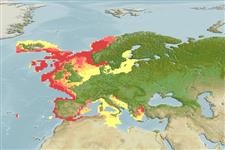Common names from other countries
Environment: milieu / climate zone / depth range / distribution range
Ecologie
; diepteverspreiding 20 - 800 m (Ref. 441), usually 200 - 600 m (Ref. 88009). Temperate, preferred 16°C (Ref. 107945); 72°N - 27°N, 25°W - 27°E
Eastern Atlantic and the Mediterranean: From Finnmark, Norway south to Libya west to the Canary Is. and east to Aegean Sea. Subtropical to polar.
Length at first maturity / Size / Gewicht / Leeftijd
Maturity: Lm 3.2, range 2 - 5.5 cm Max length : 24.0 cm BL mannelijk/geslacht niet bekend; (Ref. 441); common length : 19.0 cm BL mannelijk/geslacht niet bekend; (Ref. 441)
Total body length: 8 to 24 cm, usually between 10 to 20 cm (Ref. 4). Found in the continental shelf and slope (Ref. 94799). Epibenthic (Ref. 87524). Sedentary (Ref. 94799). Inhabits muddy bottoms in which it digs its burrows. Nocturnal and feeds on detritus, crustaceans and worms (Ref. 4). An active predator or scavenger (Ref. 94757). Another isotope data (δ15N=6.26±0.14, n=3, Ref. 106518).
Ovigerous females are found practically throughout the year, the eggs laid around July are carried for about 9 months (Ref. 4). 1 brood per year (Ref. 81133); 1.6 cm postlarval size (Ref. 81161); 1 month of pelagic period (Ref. 81160).
Holthuis, L.B. 1991. (Ref. 4)
Status op de Rode Lijst van het IUCN (Ref. 130435)
Status bij CITES (Ref. 108899)
Not Evaluated
Not Evaluated
Gebruik door de mens
Visserij: commercieel
FAO - Visserij: landings, soortsprofiel | FIRMS (Stock assessments) | FishSource | Sea Around Us
Tools
Internet-bronnen
Estimates based on models
Preferred temperature
(Ref.
115969): 3.3 - 13.7, mean 7.8 (based on 273 cells).
Weerstandsvermogen
Gemiddeld, minimale populatieverdubbelingstijd 1,4-4,4 jaar (K=0.03-0.44; tm=2).
Prior r = 0.50, 95% CL = 0.33 - 0.75, Based on 36 full stock assessments.
Kwetsbaarheid
Low vulnerability (14 of 100).
